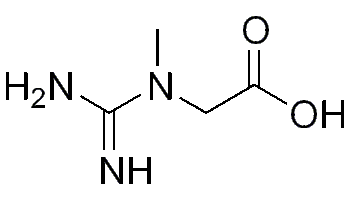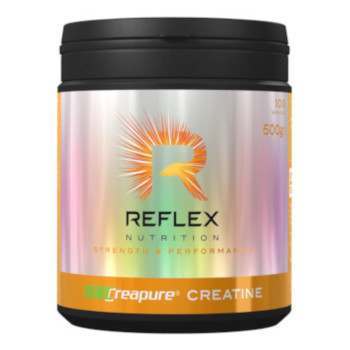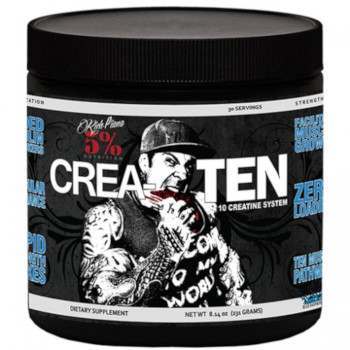Whats The Deal With Creatine?

Whats The Deal With Creatine?
Creatine is one of the most well understood supplements in the world and one of the most essential that you should be taking advantage of if your goal is to build serious lean muscle mass.
Famously, Creatine exploded into popularity after Linford Christie told newspaper that he had been using it in the run-up to his Gold Medal 100m win at the 1992 Olympics. Since then our understanding of Creatine and benefits has only improved!
But what is Creatine, how does it function and when should you use it?
What is Creatine?

Chemical makeup of Creatine
Creatine is a naturally occuring organic acid that our body is able to synthesise itself from the amino acids methionine, Glycine and Arginine. While that may sound complicated, Creatine’s not some lab-made chemical concocted by the military to create super-soldiers, it’s found naturally in the body and is the main fuel source our muscles need to create Adenosine Tri-Phosphate (ATP), the energy form required during intense anaerobic exercise such as sprinting or weight training.
During intense exercise, ATP rapidly becomes depleted, at which point your stores of Creatine step in to create fresh ATP. The result? Increased strength, power and short-term endurance during extreme power activity.

Why Should You Take Creatine Supplements?
While our diet will usually provide the resources to synthesis a limited amount creatine (and some food contains it), supplementing with pure-form creatine has been shown to effectively load your muscles with the resources they require to build lean muscle mass by increasing their ability to hydrate. This increased fluid retention could be seen as a negative, however hydrated muscles perform better during exercise and rebuild with greater effectiveness.
When Should You Take Creatine?
To get the most out of Creatine it needs to build up in your muscles and therefore can, and should be used consistently. There are two mindsets about how we should consume creatine. The simpler method is a stable daily dose of between 3-5g, which will saturate your muscles with creatine within a few weeks.
The quick-hit method is to 'load'. Loading involves taking a higher dose of around 15-25g of creatine daily, split up into smaller 3-5g servings a few hours apart. Once you’ve completed the loading phase reduce your dosage down to a daily intake of around 3-5g. This method has been shown in some studies to rapidly increase your muscles creatine stores, though the jury is still out to whether it’s definitely the most efficient or effective method of using creatine.
Are there Any Side Effects with taking Creatine?
One of the side effects of Creatine is weight gain, primarily due to the increased hydration of your muscles. This needn’t be seen as a bad thing as it’s going to be the result of increased muscle mass, although if you don’t workout to take advantage of the increased Creatine supply you’re not going to see benefits.
It’s also important to hydrate properly when taking creatine as it causes your muscles to draw water from your body to hydrate your muscles. If you’re hydrating properly (which you should be!) this is unlikely to be an issue - if in doubt, have a glass of water with every dose of creatine.
Some users may suffer from mild stomach discomfort when using Creatine, however this link hasn’t been proven, so it’s likely anecdotal for extremely limited in nature.

The Different forms of Creatine
There are a number of types of Creatine, here we’ll cover the 3 ‘big’ ones.
Creatine Monohydrate
Creatine Monohydrate used to be the most popular and widely used form of creatine. Creatine Monohydrate is a simple powder that will serve most athletes well, however these days it's been mostly superseded by Micronised Creatine as it's become cheaper.
Benefits
- Highly Effective - Assuming you’re using high quality, pure Creatine, it’s extremely effective, especially considering its cost.
- Cheap - Best thing about Creatine perhaps? It’s cheap.
- Extensively Researched - Nearly all of the research concerning Creatine has been done on Creatine Monohydrate making it the safest and most reliable form to ingest.
Negatives
- Poor Water Solubility - Creatine Monohydrate dissolves poorly in water and worse, it’s unstable in water. Mix it and drink it, quick!
- Low Surface Area - A Relatively low surface area mean that only around 1% of Creatine is absorbed by your muscles
- Upset Stomach - There is some evidence at Creatine Monohydrate is the culprit when it comes to stomach discomfort!
We haven't provided a recommendation for Creatine Monohydrate. At Echo Supplements we only supply the highest quality supplements and these days non-micronised Creatine just isn't worth buying. Stick to Micronised! (Most modern products described as Monohydrate Creatine have been micronised, so don't worry!)
Micronised Creatine
Creatine Monohydrate’s smaller brother hits harder as its smaller particle size results in a larger overall surface area for effective absorption. All of the same benefits on monohydrate but with reduced stomach discomfort.
Benefits
- Increased Effectiveness - Micronised Creatine is pretty much the same as Creatine Monohydrate but smaller, resulting in greater surface area. The end result is increased muscle absorption.
- Minimised Stomach Discomfort - For those who do suffer stomach issues with creatine mono, Micronised Creatine eliminates this issue.
Negatives
- Cost - Micronised Creatine is more expensive the Creatine Monohydrate, but only marginally these days.
Our ChoicesReflex Nutrition Creapure Creatine

Creapure , as the name might suggest: is Pure Creatine Monohydrate. Manufactured in Reflex's state of the art facility in Germany you're guarunteed to get the highest quality product. It's easy on the stomach and doesn't taste bad either (it doesn't taste of anything!), which can't be said for some creatine products!
One of our customers reviewed Creapure and described it as Outstanding Quality!!!! Nicer than boiled eggs in the morning!.
If that's not high praise, I don't know what is.
Creatine Ethyl Ester
Creatine Ethyl Ester is touted as being the most effective form of Creatine available today with a nearly 99% absorption rate.
Benefits
- Superior Absorption - Though there is some debate about this, Creatine Ethyl Ester is potentially the most effective form of Creatine on the market with a 99% absorption rate.
- Zero Stomach Issues - For those who suffer with issues Ethyl Ester Creatine is discomfort free.
Negatives
- Expensive - Compared to other forms of Creatine, Ethyl Ester is rather on the pricey side, which could make it a less attractive choice when compared to the likes of Creatine Monohydrate.
- Poorly Researched - Very little research has been done into Creatine Ethyl Ester. While it’s very unlikely to be dangerous, the real question is: How legitimate are the claims around this version of Creatine?
Our Choices Rich Piana 5% Nutrition Createn

Rather than being pure Creatine Ethyl Ester, Rich Piana's Createn contains 10 forms of creatine, including Ethyl Ester. This means you don't need to load with Createn, while it isn't anywhere near as pricy as you'd expect with a pure Ethyl Ester product. Each serving contains 5g of Creatine supported by a selection of ingredients chosen because of their ability to improve Creatine absorption
See it in the StoreConclusion

So what should we take away from all this?
Creatine is one of the safest and most reliable supplements on the market and just about any athlete can take advantage of it and see noticeable and dramatic results. The best bit? Creatine is cost effective and we KNOW it works.
